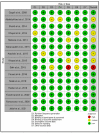A Systematic Review and Meta-Analysis of Premenstrual Syndrome with Special Emphasis on Herbal Medicine and Nutritional Supplements
- PMID: 36355543
- PMCID: PMC9699062
- DOI: 10.3390/ph15111371
A Systematic Review and Meta-Analysis of Premenstrual Syndrome with Special Emphasis on Herbal Medicine and Nutritional Supplements
Abstract
Herbal medicine and nutritional supplements are suggested to treat premenstrual somatic and psycho-behavioural symptoms in clinical guidelines; nonetheless, this is at present based on poor-quality trial evidence. Hence, we aimed to design a systematic review and meta-analysis for their effectiveness in alleviating premenstrual symptoms. The published randomized controlled trials (RCTs) were extracted from Google scholar, PubMed, Scopus and PROSPERO databases. The risk of bias in randomized trials was assessed by Cochrane risk-of-bias tool. The main outcome parameters were analysed separately based on the Premenstrual Symptom Screening Tool and PMTS and DRSP scores. Secondary parameters of somatic, psychological, and behavioural subscale symptoms of PSST were also analysed. Data synthesis was performed assuming a random-effects model, and standardized mean difference (SMDs) was analysed using SPSS version 28.0.0 (IBM, Armonk, NY, USA). A total of 754 articles were screened, and 15 RCTs were included (n = 1211 patients). Primary results for participants randomized to an intervention reported reduced PSST (n = 9), PMTS (n = 2), and DSR (n = 4) scores with (SMD = -1.44; 95% CI: -1.72 to -1.17), (SMD = -1.69; 95% CI: -3.80 to 0.42) and (SMD = 2.86; 95% CI: 1.02 to 4.69) verses comparator with substantial heterogeneity. Physical (SMD = -1.61; 95% CI = -2.56 to -0.66), behavioural (SMD = -0.60; 95% CI = -1.55 to0.35) and mood (SMD = 0.57; 95% CI = -0.96 to 2.11) subscale symptom groupings of PSST displayed similar findings. Fifty-three studies (n = 8) were considered at low risk of bias with high quality. Mild adverse events were reported by four RCTs. Based on the existing evidence, herbal medicine and nutritional supplements may be effective and safe for PMS.
Keywords: PMS; PRISMA; Web of Science; dietary supplements; female health; herbal medicine; reproductive health; software; unani medicine.
Conflict of interest statement
The authors declare that there are no conflict of interest regarding the publication of this study.
Figures















References
-
- Arabnezhad L., Mohammadifard M., Rahmani L., Majidi Z., Ferns G.A., Bahrami A. Effects of curcumin supplementation on vitamin D levels in women with premenstrual syndrome and dysmenorrhea: A randomized controlled study. BMC Complement. Med. Ther. 2022;22:19. doi: 10.1186/s12906-022-03515-2. - DOI - PMC - PubMed
-
- Purnawati J., Sinrang A.W., Jusuf E.C., Limoa E., Ahmad M., Usman A.N. Nutrition, mental status and level of 8-hydroxy-2-deoxyguanosine (OHDG) urine as predictors of premenstrual syndrome (PMS) in adolescent girls. Int. J. Curr. Res. Rev. 2020;12:7–13. doi: 10.31782/IJCRR.2020.122315. - DOI
-
- Abay H., Kaplan S. Current approaches in premenstrual syndrome management. Bezmialem Sci. 2019;7:150–156. doi: 10.14235/bas.galenos.2018.2358. - DOI
Publication types
LinkOut - more resources
Full Text Sources

